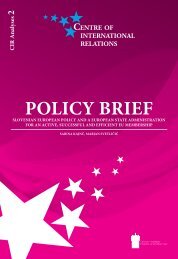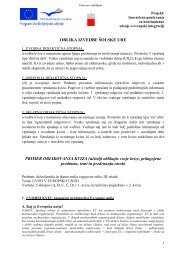national system of innovation in slovenia - Mednarodni odnosi
national system of innovation in slovenia - Mednarodni odnosi
national system of innovation in slovenia - Mednarodni odnosi
Create successful ePaper yourself
Turn your PDF publications into a flip-book with our unique Google optimized e-Paper software.
32<br />
National <strong>system</strong> <strong>of</strong> <strong><strong>in</strong>novation</strong> <strong>in</strong> Slovenia<br />
research and looser ties with bus<strong>in</strong>ess sector. Yet s<strong>in</strong>ce 1996 10 the bus<strong>in</strong>ess sector<br />
has picked up the R&D <strong>in</strong>vestment to the current level where today it provides for<br />
major source <strong>of</strong> fund<strong>in</strong>g for R&D.<br />
In terms <strong>of</strong> R&D <strong>in</strong>put <strong>in</strong>dicators (the number <strong>of</strong> researchers, the amount<br />
<strong>of</strong> public R&D <strong>in</strong>vestment, and the high level <strong>of</strong> bus<strong>in</strong>ess R&D <strong>in</strong>vestment),<br />
Slovenia scores relatively well <strong>in</strong> comparison to the EU average and is grouped<br />
<strong>in</strong> the category <strong>of</strong> ‘moderate <strong>in</strong>novator.’ More problematic is the output side,<br />
particularly if measured by number <strong>of</strong> <strong>in</strong>novative firms or the number <strong>of</strong> patents<br />
(EIS 2009). The EIS 2009 Report (EIS 2010) shows that Slovenia’s scores<br />
are higher compar<strong>in</strong>g to the EU average <strong>in</strong> the field <strong>of</strong> Human resources and<br />
Innovators, while there is a problem especially <strong>in</strong> the field <strong>of</strong> Throughputs and<br />
firm <strong>in</strong>vestments.<br />
Figure 3.2: Average efficiency <strong>of</strong> R&D spend<strong>in</strong>g and share <strong>of</strong> expenditure on R&D <strong>in</strong><br />
GDP<br />
0,9<br />
0,8<br />
0,7<br />
0,6<br />
0,5<br />
0,4<br />
0,3<br />
CY<br />
BG<br />
MT<br />
GR<br />
SK<br />
LT<br />
PT<br />
EE<br />
HU<br />
IT<br />
ES<br />
IE<br />
CZ<br />
LU<br />
UK<br />
NO<br />
NL<br />
SI<br />
AT<br />
FR<br />
US<br />
DK<br />
BE<br />
DE<br />
CH<br />
JP<br />
FI<br />
SE<br />
0,2<br />
0,1<br />
1,0<br />
0,0 0,5 1,0 1,5 2,0 2,5 3,0 3,5 4,0<br />
RO<br />
LV<br />
PL<br />
Source: Measur<strong>in</strong>g the efficiency <strong>of</strong> public spend<strong>in</strong>g on R&D (EC) 2009.<br />
Note: Efficiency <strong>of</strong> R&D spend<strong>in</strong>g is measured by the number <strong>of</strong> patents per million <strong>of</strong> population<br />
and scientific excellence (number <strong>of</strong> scientific publications per million <strong>of</strong> population and<br />
their quotations). *Due to the comparability and availability <strong>of</strong> data, the figure shows data for<br />
2001–2006 for all countries, while for Slovenia the latest data are also available, <strong>in</strong>dicat<strong>in</strong>g positive<br />
shifts.<br />
10 In 1993, the bus<strong>in</strong>ess sector contributed 38 % <strong>of</strong> R&D expenditures; while the public sector<br />
share accounted for 58 % (total R&D expenditure <strong>in</strong> 1993 was 171 million EUR). Already by<br />
1996, the bus<strong>in</strong>ess sector’s allocation was higher and amounted to 49 % <strong>of</strong> total expenditures<br />
<strong>of</strong> 217 million EUR (Bučar and Stare 2006).





